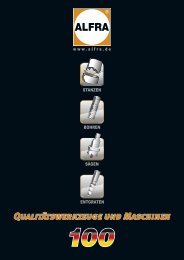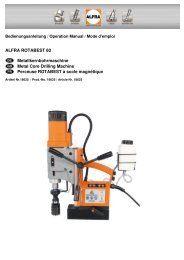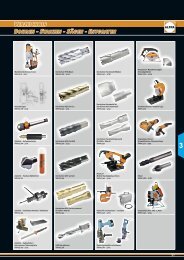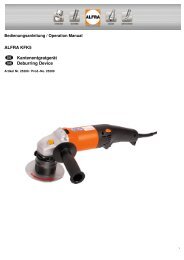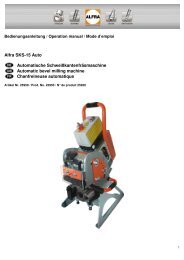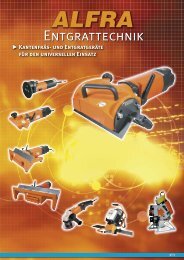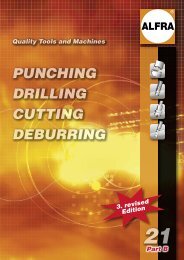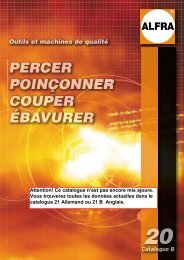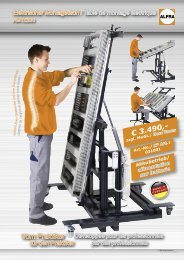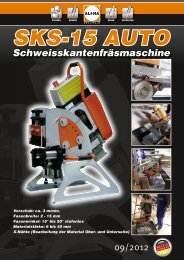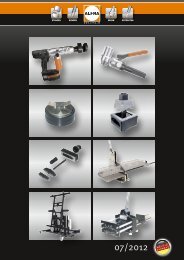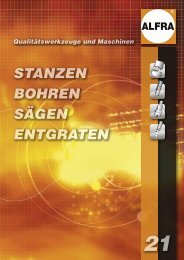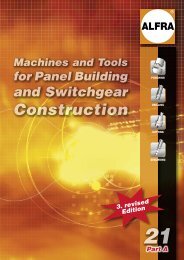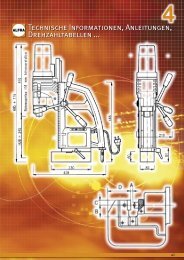You also want an ePaper? Increase the reach of your titles
YUMPU automatically turns print PDFs into web optimized ePapers that Google loves.
Punching Unit APS 60/70/120 – Notes on use<br />
How to select the correct ratio of material thickness to tool size<br />
The choice of the proper tool size at a given material thickness is a usual<br />
question in daily practice.<br />
For customary punch models, an old rule says that the minimum tool size<br />
is the material thickness.<br />
This rule is no more valid for our hydraulically actuated punches.<br />
The rule only still applies for fast moving mechanical presses: Thicker<br />
materials could cause the punch to break.<br />
With our ALFRA PRESS APS-punches, the process is carried out by a<br />
smooth, slow motion allowing the punching of holes with a diameter<br />
smaller than the material thickness.<br />
But still, a certain minimum diameter has to be respected. For that<br />
reason, we have carried out tests, and the results are demonstrated in<br />
fig.1. Example:<br />
You want to punch holes into a steel plate made from DIN S233. Which is<br />
the correct ratio of material thickness to tool size?<br />
The shear strength of the material is at 30 kg/mm 2 approx. The recommended<br />
ratio is represented by line A. The corresponding value on the<br />
ordinate is 1.3.<br />
Result: The recommended ratio is 1.3.<br />
The upper tolerance limit for that ratio is represented by line B which at<br />
this point gives an ordinate value of 1.7. Hence, it is possible to punch<br />
holes with a diameter of only 1/1.7 of the material thickness. You may<br />
use this tolerance value for exception, but the service life of the tool will<br />
be significantly reduced.<br />
We would like to remind you only to use line A for the correct determination<br />
of the ratio of material thickness to hole size.<br />
Proper ratio at a given shear strength<br />
Ratio of material thickness to tool size<br />
Shear strength<br />
Minimum tool size at a given material thickness<br />
B<br />
At a given material thickness, fig. 2 can be used for the rapid determination<br />
of the tool size. The values for Al, Cu, DIN S233 and St 70 are<br />
indicated.<br />
Example:<br />
You want to punch holes into a steel plate of DIN S233; the material<br />
thickness is 20 mm. Which is the minimum hole diameter to be punched?<br />
Look for the corresponding value on the solid line.<br />
Result: Minimum hole diameter is 15 mm.<br />
The dashed line represents the upper tolerance values, which can be<br />
used only for exception (reduced tool life).<br />
We recommend you to select the hole size by means of the solid line.<br />
ALFRA punches and dies are made of high-quality materials. But still,<br />
sometimes a tool may break.<br />
The following reasons have to be taken into account:<br />
1. Incorrect selection of the ratio of tool size to material thickness.<br />
2. The material is not aligned straight on the die.<br />
3. Disturbing movements during the punch process.<br />
4. The hold-down is damaged, or its height is not adjusted correctly, so<br />
that the material will be tilted during the removing of the punch.<br />
5. The distance between hold-down and tool is too large. Thin sheets<br />
can be bended during the removing of the punch. In such cases, the<br />
tool breaks at the cutting edge in the form of thin leaves.<br />
Tool size<br />
In that case we recommend the hold-down to be equipped with a<br />
bridge or the utilization of a special hold-down.<br />
1 2<br />
Material thickness<br />
B/133



